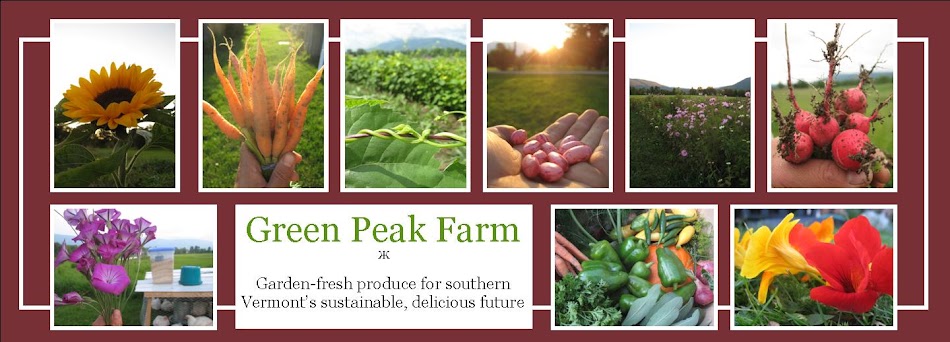A couple of important notes:
Your next two chickens will be ready for pickup this Saturday, anytime after 2pm. You are welcome to pick them up fresh anytime Saturday or Sunday. After that they are going into the freezer, and can be picked up on Tuesday with your next share.
In your share this week:
basil
cucumbers
summer squash
carrots
green and purple beans
fennel
beets
parsely
cilantro
lettuce mix
red onions - loose
yellow onions - loose
bunch of cippolini onions
bunch of red shallots
green peppers
More peppers are coming on this week, as well as onions. You can use the onion tops to add a dash of flavor and color just like scallions, and I'm excited to run a few taste-test-trials to see how great a difference there is in using shallots, cippolini, red, and yellow onions. Please let me know your thoughts!
Onion family bulbs store best in the dark of the refrigerator, and if you're interested in keeping the greens crispy, store them in an untied plastic bag. If you don't intend to use your onions/shallots/cipps in the next few weeks, you can "cure" them for storage by bending the greens back and leaving them in the sun for a few days. The sun cues the bulb to develop a thin, papery shell to help prevent bruising and permeability-- like wrapping itself in a brown paper bag. All onions that you purchase in a grocery store have been cured-- and then stored from the summer. As onions and allia are one of the few commercial crops that are sensitive to seasonal day-length periods, they can only be grown in the summer. Of course, we can't forget about South America and the southern hemisphere-- but still, that only gives us, as eaters in a modern, global community, two growing seasons for onions. Scallions and leeks are, to some extent, exceptions.
Here's a pickle recipe, as promised. Adapted from the Ball Complete Book of Home Preserving
Dill Sandwich Slices-- Makes about 5 pint jars. I like this recipe because it takes the "cold pack" method-- you don't have to cook the cucumbers twice, which is faster, neater, and ends with a nice, crispy pickle.
Ingredients:
3 tbsp pickling spice (available in bulk at natural food stores)
4 cups cider vinegar
4 cups water
3/4 cup granulated sugar
1/2 cup pickling or canning salt (non-iodized)
5 bay leaves
5 cloves garlic
2.5 tsp mustard seeds
5 heads fresh dill
13.5 cups sliced, trimmed pickling cukes
Other supplies:
mason jars with metal bands and lids
medium square of cheesecloth
large ladle
clean dish towels
towel-covered cutting board for letting jars rest overnight.
I also really like having the gizmos that Ball sells for canning-- small tools that make everything very easy and neat--jar grabbers for removing jars from water or steam bath, a medium-sized funnel for filling jars with liquid, and a small, magnetic lid grabber to get them out of hot water without burning fingers.
1. Prepare canner, jars and lids. I prep these in a dishwasher, making sure that your dishwasher has a "sterilize" setting. While these are washing and heating up, wash, trim, and slice cukes into spears, and prep garlic cloves.
2. Tie pickling spice in a square of cheesecloth, creating a spice bag.
3. In a large stainless steel saucepan combine vinegar, water, sugar, pickling salt and spice bag. Bring to a boil over med-high heat, stirring to dissolve sugar and salt. Reduce heat and boil gently for 15 minutes, until spices have infused the liquid.
4. [I like to go jar by jar, start to finish here-- keeps things hotter, in my opinion, but the book has you ...] Place 1 bay leaf, 1 garlic clove, 1/2 tsp mustard seed and 1 head of dill into each jar. Pack cucumbers into hot jars to within a generous 1/2 inch of the top of jar.
5. Ladle hot pickling liquid into jar to cover cucumbers, leaving 1/2 inch headspace. Remove air bubbles and adjust headspace, if necessary, by adding hot pickling liquid. Wipe rim. Center lid on jar. Screw band down until resistance is met, then increase to finger-tight.
6. Place jars in canner, ensuring they are completely covered with water. Bring to a boil and process for 15 minutes. Remove canner lid. Wait 5 minutes, then remove jars, cool, and store.
Disclaimer: this recipe is not recommended for first-time canners, as risks exist with food preservation (as in all things) and I can't be held responsible for mistakes or incorrect information. Please familiarize yourself with basic canning techniques before consulting this recipe! Whew!
Anyway, this recipe also works well if, instead of canning for long-term storage, you just want cooked pickles -- in which case, skip all the jar parts and toss everything in the pot! This style of pickles should keep in the fridge for 2 weeks or so.
Chickens Saturday!

No comments:
Post a Comment